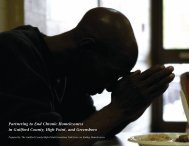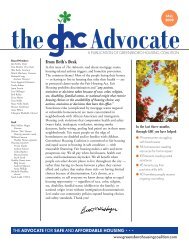data - Greensboro Housing Coalition
data - Greensboro Housing Coalition
data - Greensboro Housing Coalition
Create successful ePaper yourself
Turn your PDF publications into a flip-book with our unique Google optimized e-Paper software.
the men who are being counted in the AHAR as unaccompanied individuals may be part of<br />
intact families that are housed elsewhere. 14 Also, the HMIS <strong>data</strong> presented here do not<br />
include adults served by domestic violence providers, most of whom are women.<br />
Single-person households. Two-thirds (67 percent) of the total sheltered population were in<br />
single-person households, nearly 2 times the proportion of these households in poverty and about<br />
1.5 times the national proportion. As shown in Exhibit 3-1, most homeless people in singleperson<br />
households were men, and thus the reasons both single-person households and men are<br />
disproportionately represented in the sheltered homeless population are likely the same.<br />
People age 31 to 50. Two-fifths (40 percent) of the sheltered homeless population were<br />
between the ages of 31 to 50, compared to only 29 percent of the total U.S. population and 22<br />
percent of the poverty population. Middle-aged people may be more likely to be homeless<br />
because substance abuse or mental illness issues become more acute during this life stage. If<br />
people have struggled for a while because of mental health, substance abuse, or financial<br />
issues, by age 30 or older they may have exhausted their alternatives for living with friends<br />
and family. The shelter system may be their last remaining option.<br />
People with disabilities. Among adults, 17.7 percent of the U.S. population had a disability<br />
whereas an estimated 42.8 percent of sheltered homeless adults had a disability. 15 A<br />
disability, particularly one relating to substance abuse or mental health issues, can make it<br />
difficult to work enough to afford housing. Indeed, the higher share of adults with disabilities<br />
in the poverty population (30.7 percent) relative to the U.S. population is an indication of this<br />
difficulty. People with disabilities are an even higher share of the homeless population than<br />
the poverty population, suggesting that disabled persons face additional difficulties in gaining<br />
access to permanent housing. People with disabilities may have difficulties searching for a<br />
unit or finding a landlord willing to rent to them. Their disability may make it less easy to<br />
accommodate them without adaptive supports.<br />
Also, the ability of SSI and SSDI to avert homelessness among persons with disabilities is<br />
uncertain. In 2009, the average monthly SSI payment was $504 16 (or about $6,048 annually) and<br />
14<br />
15<br />
16<br />
A study of patterns of homelessness among families in four communities—Houston TX, Washington DC,<br />
Kalamazoo MI, and upstate South Carolina—tracked people from their first entry into the homeless services<br />
system (based on HMIS <strong>data</strong>) for 18 months (30 months in DC) and found that many adults who were<br />
homeless as part of a family during part of the tracking period used shelters for individuals at other times<br />
during the tracking period. Brooke Spellman, Jill Khadduri, Brian Sokol, and Josh Leopold, Costs<br />
Associated with First-Time Homelessness for Families and Individuals. U.S. Department of <strong>Housing</strong> and<br />
Urban Development, forthcoming 2009.<br />
HUD’s definition of disabling condition is broader than the definition used by the U.S. Census Bureau. See<br />
footnote 12 for more information.<br />
U.S. Social Security Administration Office of Retirement and Disability Policy. Monthly Statistical<br />
Snapshot, March 2009. Available at http://www.ssa.gov/policy/docs/quickfacts/stat_snapshot/.<br />
Chapter 3: Sheltered Homeless People in 2008 27




